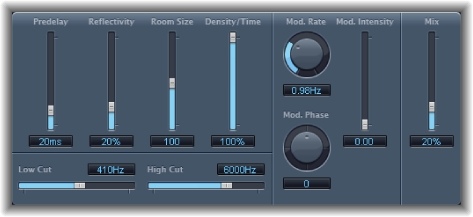SilverVerb
The SilverVerb is similar to the AVerb, but it provides an additional LFO that can modulate the reverberated signal. It also includes a high cut and a low cut filter, allowing you to filter frequencies from the reverb signal. High frequencies usually sound somewhat unpleasant, hamper speech intelligibility, or mask the overtones of the original signals. Long reverb tails with a lot of bottom end generally result in an indistinct mix.
Predelay slider and field: Determines the time between the original signal and the reverb signal.
Reflectivity slider and field: Defines how reflective the imaginary walls, ceiling, and floor are.
Room Size slider and field: Defines the dimensions of a simulated room.
Density/Time slider and field: Determines both the density and the duration of the reverb.
Low Cut slider and field: Frequencies below the set value are filtered out of the reverb signal. This affects only the tone of the reverb signal, not the original signal.
High Cut slider and field: Frequencies above the set value are filtered out of the reverb signal. This affects only the tone of the reverb signal, not the original signal.
Mod(ulation) Rate knob and field: Sets the frequency (the speed) of the LFO.
Mod(ulation) Phase knob and field: Defines the phase of the modulation between the left and right channels of the reverb signal.
At 0°, the extreme values (minimum or maximum) of the modulation are achieved simultaneously on both the left and right channels.
At a value of 180°, the extreme values opposite each other (left channel minimum, right channel maximum, or vice-versa) are reached simultaneously.
Mod(ulation) Intensity slider and field: Sets the modulation amount. A value of 0 turns the delay modulation off.
Mix slider and field: Sets the balance between the effect (wet) and original (dry) signals.
